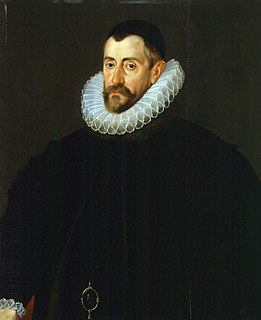
Sir Francis Walsingham was principal secretary to Queen Elizabeth I of England from 20 December 1573 until his death and is popularly remembered as her "spymaster".

Earl of Yarborough is a title in the Peerage of the United Kingdom. It was created in 1837 for Charles Anderson-Pelham, 2nd Baron Yarborough.

Charles Howard, 1st Earl of Nottingham, 2nd Baron Howard of Effingham, known as Howard of Effingham, was an English statesman and Lord High Admiral under Elizabeth I and James I. He was commander of the English forces during the battles against the Spanish Armada and was chiefly responsible for the victory that saved England from invasion by the Spanish Empire.

Sir Thomas Fleming was an English judge and politician who sat in the House of Commons at various times between 1581 and 1611. He was judge in the trial of Guy Fawkes following the Gunpowder Plot. He held several important offices, including Lord Chief Justice, Lord Chief Baron of the Exchequer and Solicitor General for England and Wales.

Henry Percy, 9th Earl of Northumberland, KG was an English nobleman. He was a grandee and one of the wealthiest peers of the court of Elizabeth I. Under James I, Northumberland was a long-term prisoner in the Tower of London, due to the suspicion that he was complicit in the Gunpowder Plot. He is known for the circles he moved in as well as for his own achievements. He acquired the sobriquet The Wizard Earl, from his scientific and alchemical experiments, his passion for cartography, and his large library. His mild deafness and slight speech impediment did not prevent him from becoming an important intellectual and cultural figure of his generation.

Sir William Brooke, 10th Baron Cobham, KG, lord of the Manor of Cobham, Kent, was Lord Warden of the Cinque Ports, and a Member of Parliament for Hythe. Although he was viewed by some as a religious radical during the Somerset Protectorate, he entertained Queen Elizabeth I of England at Cobham Hall in 1559, signalling his acceptance of the moderate regime.

Elizabeth, Lady Coke, was an English court office holder. She served as lady-in-waiting to the queen consort of England, Anne of Denmark. She was the daughter of Thomas Cecil, 1st Earl of Exeter, and Dorothy Neville, and the granddaughter of William Cecil, 1st Baron Burghley. She was the wife of Sir William Hatton and later of Sir Edward Coke.

Thomas West, 2nd and 11th Baron De La Warr of Wherwell Abbey, Hampshire, was a member of Elizabeth I's Privy Council.

Frances Burke, Countess of Clanricarde and Dowager Countess of Essex was an English noblewoman. The daughter of Sir Francis Walsingham, Elizabeth I's Secretary of State, she became the wife of Sir Philip Sidney at age 16. Her second husband was Queen Elizabeth's favourite, Robert Devereaux Earl of Essex, with whom she had five children. Two years after his execution in 1601, she married Richard Burke, Earl of Clanricarde, and went to live with him in Ireland.

Frances Seymour, Duchess of Somerset, was an English noblewoman who lived during the reigns of Elizabeth I, James I, Charles I and Charles II. Her father was Robert Devereux, 2nd Earl of Essex, Elizabeth I's favourite who was executed for treason in 1601. She was the second wife of William Seymour, 2nd Duke of Somerset, and the mother of his seven children.

Sir Richard Worsley, 7th Baronet,, of Appuldurcombe House, Wroxall, Isle of Wight, was a British politician who sat in the House of Commons between 1774 and 1801. He was a noted collector of antiquities.

Seymour Dorothy Fleming, styled Lady Worsley from 1775 to 1805, was a member of the British gentry, notable for her involvement in a high-profile criminal conversation trial.

Giles Brydges, 3rd Baron Chandos of Sudeley was an English courtier in the reign of Elizabeth I.

Dorothy Bray, Baroness Chandos was an English noblewoman, who served as a Maid of Honour to three queens consort of King Henry VIII of England; Anne of Cleves, Catherine Howard, and Catherine Parr. From 1541 to 1543, she had an affair with the latter's brother, William Parr, 1st Marquess of Northampton, whose own wife, Anne Bourchier, 7th Baroness Bourchier had eloped with a lover.

George William Coventry, 7th Earl of Coventry, styled Viscount Deerhurst until 1809, was a British peer and Member of Parliament.
Sir Richard Worsley, 1st Baronet was an English landowner and politician who sat in the House of Commons between 1614 and 1621.
Margaret Bourchier, Countess of Bath was an English Tudor noblewoman. She is notable for the three high-profile and advantageous marriages she secured during her lifetime, and for her success in arranging socially impressive marriages for many of her children. Through her descendants she is common ancestor of many of the noble families of England.
Lady Audrey Walsingham was an English courtier. She served as Lady of the Bedchamber to queen Elizabeth I of England, and then as Mistress of the Robes to Anne of Denmark from 1603 until 1619.
Sir Ambrose Turvile, (1581-1628), Courtier and cupbearer to Anne of Denmark.

Elizabeth Howard (1564—1646) was an English aristocrat and courtier to Elizabeth I of England.
















